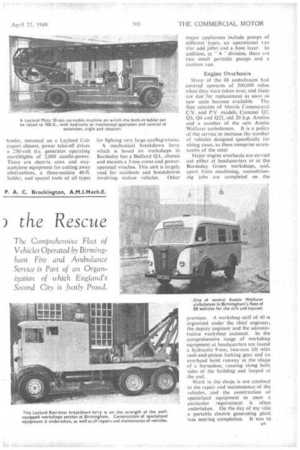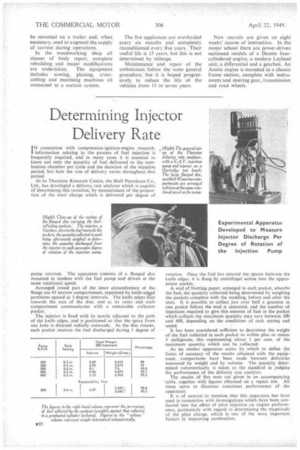In Sickness or Fire Road Vehicle
Page 16

Page 17

Page 18

If you've noticed an error in this article please click here to report it so we can fix it.
) the Rescue
AT the headquarters of the Birmingham Fire and Ambulance Service there are two adjoining control rooms, one for each branch of the service, and it is in these two rooms that the whereabouts and movement of every vehicle are charted. The organization of the service in respect of fire cover provides, with few exceptions, for a maxiMum travelling time to fires, anywhere within the city, of six minutes, although in practice it is rarely longer than four minutes.
Engines Kept Warm
"This button starts the engine of one of the fire appliances," I was told. • "It's an escape machine—our latest, fully enclosed type. This button op4ns the doors of the section. We don't always use the starter switch. The driver is there a few seconds after the alarm goes and he -likes to do the job himself."
The need for warming-up before starting seemed the obvious reason, but I was wrong. "The engines of all the appliances are kept at 100 degrees F. We use immersion heaters for that. The appliances are out on a call in 30 seconds."
The service is organized with the close co-operation of the police, and six vehicles are kept in reserve specifically for catastrophe duty In the event of a call a predetermined number of ambulances is sent out and, at the same time, all other ambulances on removal cases are mobilized. The appropriate first attendance of fire appliances to the incident zone is dispatched and eight additional pumps are mobilized in the first stage a8 at the city centre or the scene of the accident.
Appliances for fighting every type of outbreak are included in the reserve group and the breakdown vehicle can deal with any lifting or high traction job that is likely to be met. The rescue tender is expressly designed to facilitate the release of entrapped casualties from collapsed structures or • framework, and to accommodate them after rescue. platform and there are two additional winches, and a variety of equipment for dealing with any type of street accident.
Two 10-ton turntable ladders— one a Leyland Metz, and the other a Dennis Merryweather with a 100 b.h.p. Meadows engine—are capable of raising the built-in ladders to 100 ft. with hydraulic or mechanical operation and control of extension, angle and rotation. In the rescue Premises. A workshop staff of 40 is organized under the chief engineer,
the deputy engineer and the administrative workshop assistant. In the
comprehensive range of workshop equipment at headquarters are found a hydraulic 9-ton, two-ram lift with rack-and-pinion locking gear and an overhead hoist runway in the shape of a horseshoe, running along both sides of the building and looped at the end.
Work in the shops is not confined to the repair and maintenance of the vehicles, and the construction of specialized equipment to meet a particular requirement is often undertaken. On the day of my visit a portable electric generating plant was nearing completion. It was to
be mounted on a trailer and, when necessary, used to augment the supply of current during operations.
In the woodworking shop all classes of body repair, complete rebuilding and major modifications are undertaken. The equipment includes sawing, planing, crosscutting and mortising machines all connected to a suction system. The fire appliances are overhauled every six months and completely reconditioned every five years. Their useful life is 15 years, but this is not determined by mileage.
Maintenance and repair of the ambulances follow the same general procedure, but it is hoped progressively to reduce the life of the vehicles from 13 to seven years.
New recruits are given an eight weeks' course of instruction. In the motor school there are power-driven sectioned models of a Dennis font.cylindered engine, a modern Leyland unit, a differential and a gearbox. An Austin engine is mounted in a chassis frame section, complete with instruments and steering gear, transmission and road wheels.


























